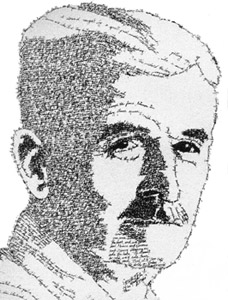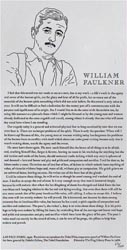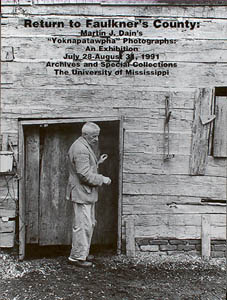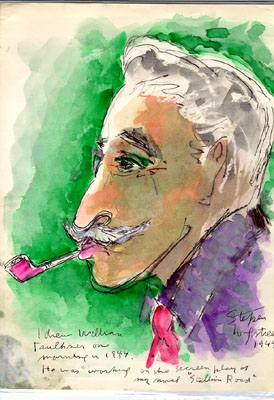

|
Faulkner Studies and Miscellany |
 |
John Sokol, 1947- . "William Faulkner as The Sound and the Fury." [N.p.], 1977.John Sokol is an American paint er, printmaker, and author. In the 1970s he created a set of micrographic portraits of authors composed of words from their own writings. This one of William Faulkner is part of the portfolio of silkscreen prints first shown at the Gotham Book Mart Galler y in New York City from February 20 to March 10, 1978. Other authors in the series are Ezra Pound, Charles Beaudelaire, Virginia Woolf, Franz Kafka, James Joyce, Samuel Beckett, Jorge Luis Borges, and Eugene O'Neill. |
William Fau lkner.[Nobel Prize Acceptance Speech].[N.p.]: The King Library Press, 1986.On November 10, 1950, Faulkner received a telephone call from Sven Åhman, New York correspondent of Dagens Nyheter, telling him that the Swedish Academy had resolv ed to confer on him the 1949 Nobel Prize for Literature. The prize would be accompanied by an award of $30,171. Even after the formal call was received, Faulkner's response was quiet, reserved, and summed up by his remark to his friend, Mac Reed, "Mac, I still can't believe it." By the time of the ceremony in December, however, Faulkner had somewhat adjusted to his new-found fame and had been persuaded to travel with his daughter to Stockholm. Although he still believed that "My soul isn't my own unti l the whole mess is over," he bought a new suit, arrived in Sweden, and prepared to endure nearly two weeks of uninterrupted show. His acceptance speech was delivered rapidly, too softly for most to hear, and with a heavy Southern accent enhanced by t he occasion. But the words were powerful, a stirring statement of faith and affirmation, as meaningful to readers at the turn of the millennium as they were to his audience then. |
 |
 |
David Levine. [William Faulkner.] [N.p.]: 1963, 1991, 1996.Artist David Levine graduated from the Tyler School of Fine Arts, Philadelphia, in 1949, later studying with Hans Hofmann. He has had many one-man shows exhibiting works in oil, watercolor, and charcoal. In addition, he has been publishing literary caricatures in The New York Review of Books since 1963. |
Three of his best are these of William Faulkner. The one from 1963, the barefoot Faulkner in patched overalls, is number eight in a publication of fifteen, Literary Caricatures by David Levine from the New York Review of Books (New York, 1964). The illus tration on the cover of the book, The Best of Bad Faulkner, is a version of one he first created in 1964. He then revised it again in 1996 at the request of Faulkner collector, Irwin T. Holtzman. |
 |
 |
Saul Rosenberg. "Delta Faulkner," in American Way, volume 23, no. 15 (August 1, 1990).This issue of American Way presents the inaugural Faulkner Write-Alike Contest, co-sponsored by American Way magazine and the Yoknapatawpha Press at the University of Mississippi. The challenge was issued "to write the best bad imitati on of one of the greatest masters of the English language." Six hundred fifty people responded, and the ten best entries were published here, having been selected by judges William Styron, George Plimpton, and Willie Morris. Highest honors went to Sau l Rosenberg, who at the time was writing a doctoral dissertation on Faulkner at Columbia University. Those that did not make the top ten but still deserved recognition were published in the little book, The Best of Bad Faulkner (Harcourt Brace Jova novich, 1991), shown above, which also includes several parodies from the past. Most interesting is Faulkner's own "Afternoon of a Cow," a story he wrote in 1935 in which he parodies himself. The "author" is Ernest V. Trueblood. |
Fl yers and posters from University of Mississippi Faulkner events.The Faulkner conference described by Mr. Rosenberg in his "Faux Faulkner" essay is, no doubt, one of the annual conferences held on the University of Mississippi campus, usually dur ing late July and early August. They began in 1973 and are still attracting the "editors and publishers and critics" Rosenberg mentions, as well as writers, students, collectors, and just plain "fans." Topics reflected on these advertising flyers are quit e typical. |
 |
 | Portrait of
William Faulkner. Watercolor by Steven Longstreet. |
John Faulkner (1901-1963). Cabin Road Series. New York: Fawcett Publications, 1951, 1952, 1955 , and 1959.William Faulkner's brother John published his first three novels in the traditional hardbound format with conservative dust jackets. All were noticed and well-reviewed by critics and academi cs. But Cabin Road, while probably revealing his most characteristic and highly developed style as a humorist, was reviewed by only one magazine of any status when it appeared in 1951. This is due primarily to the fact that it ( and the four sequels shown here) was published as a twenty-five cent paperback with a sexy girl and a ramshackle cabin on the front cover. The title (not selected by Faulkner) plus the format and cover design all suggest a c heap imitation of Erskine Caldwell's Tobacco Road, which likely kept discriminating readers away. Nevertheless, more than one million copies were sold, and in a letter to his editor at Fawcett Publications, John stated that he was glad to be published by Gold Medal which for him was less restrictive (except for number of words) and which provided a ready means of reaching his readers. |

|